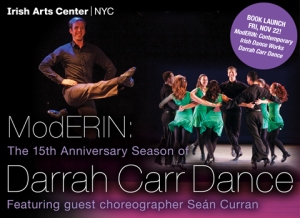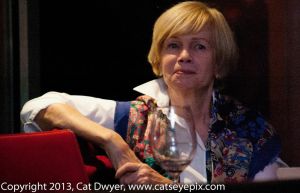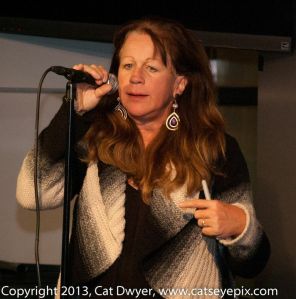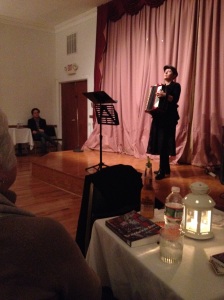Dr. Cherie Ann Turpin is currently at work on a scholarly treatise about Gabriel Byrne. She is particularly interested in Mr. Byrne’s activities surrounding the Irish Diaspora, as well as aspects of gender and celebrity culture in relationship to him as an actor and performer. She and I have discussed his film career, his work as Cultural Ambassador for Ireland, and his published works. Dr. Turpin is also interested in fan culture; Byrneholics Online is included as a resource in her celebrity culture course this Fall. It is my pleasure to bring you this guest review by Dr. Turpin, who attended the recent Narrative 4 event in New York City and generously agreed to share her thoughts and insights about Mr. Byrne’s performance at the event, as well as her observations and ideas about the Narrative 4 Project in general. I thank her for her participation here at Byrneholics! –Stella
“Manly Voice: Gabriel Byrne at Symphony Space”
I had a really difficult time writing this guest post for a variety of reasons, most of which involved me coming to understand what sort of response I wanted to give to readers with regard to my take on Gabriel Byrne’s reading last week. The following essay is not so much a review as it is a slight critique and a partial analysis of his performance.
On the one hand, I was pleased to see Gabriel Byrne set the mood of the evening with his reading of Roddy Doyle’s tongue-in-cheek contribution to the anthology. Byrne’s dry, humorous style of reading matched Doyle’s sardonic wit in engaging the following question: “how does one be[come] a man?” Byrne captured the intensity of discursive tension between women and men embedded in Doyle’s untitled short story (none of the stories in Colum McCann’s collection were titled). Further, Byrne effectively connected with the audience as a reader, suggesting either a return to familiar ground or signifying a transformative phase in his artistic career. All new beginnings, however, come with caveats. Byrne’s appearance at Symphony Space for “How to Be a Man” on November 6, 2013, produced more questions than answers about overarching themes of this program, not the least of which is the yet to be answered question: what did hosts Colum McCann and Terry Tempest Williams mean by “radical empathy,” and “diversity” within the context of such a provocative title as “How to Be a Man?” I came away from this performance with some mixed feelings about what I saw on stage.
 Gabriel Byrne. Picture provided by Sandra Markus on Twitter
Gabriel Byrne. Picture provided by Sandra Markus on Twitter
McCann’s work as host of this program and his work as editor of the anthology The Book of Men that inspired last Wednesday’s program, demonstrates a commitment to bringing writers from a variety of communities around the globe into an ongoing conversation about perceptions and experiences of manhood and masculinity. The idea of stories to be performed by actors and writers certainly has an appeal that draws a diverse audience coming from a variety of communities. However, I was perplexed as to why more of the contributing writers could not have been invited to appear in this program to perform their own works, especially those whose voices and perspectives speak to cultural perspectives and experiences different from most of the performers on stage. Diversity and empathy, both concepts which were discussed during McCann and Williams’ introductions, were presented as driving forces behind Narrative Four (the literary salon sponsoring the event) and behind the organizing principles of the anthology The Book of Men, but with the exception of the host B.D. Wong (who did perform one piece but whose work does not appear in the anthology), the three men who spoke were white, male, and heterosexual (McCann, Byrne, and the actor Corey Stoll).
Of the three women who performed in this program, only one had actually contributed to the anthology, rising literary star Tea Obreht. To the credit of the organizers, Rebecca Naomi Jones, an African American woman, also performed, as well as Stockard Channing. Both women are accomplished and respected performers known for their work in theatrical productions on Broadway, as well as for their work in film and television. Given the theme and subthemes of this program, as well as the proximity of the venue to Black and Spanish Harlem, how difficult would it have been to invite more men of color to participate in this performed conversation? I ask this question not to tear down the efforts of McCann, Williams, or even Byrne, but to further the conversation and to challenge them to engage in a more rigorous discussion as to what “diversity” means to them and even more importantly, to understand what “empathy” means to them. To me, an artistic collective sensitive to the political baggage these words carry would have been more inclined to sharing the stage with young and older men of color who have been challenged with that question of “how to be a man” in a city with a justice system that views them as criminal by default, and therefore subject to frisk-and-search, and in other regions of the United States, murdered without penalty through stand-your-ground laws. Indeed, the question of “how to be a man” takes on a more ominous tone when one’s existence is challenged by those vested in the hegemony feeding institutional racism and classism.

Gabriel Byrne with attendee Renee Olson, who provided the picture on TwitterMoreover, the significance of the celebrity persona cannot be ignored as a contributing factor to Byrne’s presence on stage. After all, his name and face became the marketing lure to encourage the audience to fill the seats, which says something about celebrity and masculinity, though Byrne was also faced with the vulnerability of being “that guy,” the famous person headlining an event who does not read his own work until the end, thereby risking a very big fail after producing audience anticipation and longing to hear his work. Although Byrne is not known for publishing fiction, he is known for publishing nonfiction, including his memoir Pictures in My Head (1994), essays in various magazines and newspapers, and several book reviews. McCann’s praises of his fiction writing during the program leads me to ask why more of his writing was not featured in this event, and further, why we have not seen more of his creative writing published as of late, save for the Esquire piece. His memoir is now out of print, and except for the recent book reviews, he has not consistently published poetry, fiction, or creative nonfiction.
It is not unreasonable to expect that someone being featured in an anthology with well-known and respected authors would have significant works to present to an audience more accustomed to seeing him perform other people’s works as an actor. Byrne is a writer to watch, but one expects to see much more coming from him as a writer. Given his recent challenges to established social institutions, he is more than capable of challenging socially dominant notions of masculinity through his writing. That means writing about those childhood traumas he mentioned Wednesday night with a certain clarity and a refusal to equivocate or mask the impact those traumas made on his ability to understand or perform masculinity, especially within the context of celebrity culture. In other words, the audience needs to see and hear more of his writing.
Significantly, Byrne’s reading of Vanessa Manko’s story came across as his most significant and subversive performance of the evening, possibly coming closest to dismantling his own celebrity persona, and at the same time offering a glimpse into his challenges as someone whose body is often hyper-sexualized and objectified. Here, McCann introduces Byrne’s reading Manko’s story by informing the audience that she wrote it in a “man’s voice,” describing the story as “naughty.” The story itself describes an encounter between an unnamed narrator in slightly ambiguous terms that could be construed as somewhat more sexually intimate than what turns out to be: it is a story about a tango dance routine, albeit one curiously absent of the sexual tension and erotic battle for dominance between the male and female partners—none of the pull or challenge from the female partner to take over the lead occurs in this story [credit given to artist and student F. Steven Kijek for pointing out the erotic subtext in tango during a discussion of this post in my Celebrity Culture class November 13, 2013]. After watching Byrne read and listening to his version of the “man’s voice,” I felt that McCann calling Manko’s story “naughty” seemed a bit dated in perspective, and somewhat retro with regard to gender roles. Is it naughty because a woman wrote it, or because she’s writing about longing from a man’s perspective?
 Gabriel Byrne. Picture provided by Misty Shores on Twitter
Gabriel Byrne. Picture provided by Misty Shores on Twitter
Again, questions arise regarding how a possibly subversive perspective becomes muted and contained when a man reads the “naughty” text. As Byrne completed his reading with the climactic revelation that the story was an elaborate description of a tango dance, he abruptly walked off the stage with the audience reacting enthusiastically and perhaps with relief that the story did not cross over into being truly transgressive. But could it be transgressive? A woman writing about a dance routine from a man’s perspective regarding his female partner constructs not only a male gaze, but also a female gaze, which in turn was presented to the audience with a male voice by Gabriel Byrne, who is, as the featured performer, presented to a largely female audience to be objectified as a stand-in and embodiment of “naughty” “male voice.”
What we attempt to encode with gender signs becomes a series of performances, expectations with the inevitable repetition that fails to meet the ideal. Was the narrator a man’s voice, or was it a woman idealizing a man’s voice? Traditionally, we are instructed to not mix the author with the narrator, but since we were offered the small cue that the author was writing in a man’s voice, I wonder if that means the narrator is a man’s voice, or the author is writing “like a man.” Whenever I hear someone claiming a voice to be understood as one gender, I tend to read against the grain, and I listen and gaze against the grain because the imposed exclusion tends to invite subversion of that reading or assumption. As an audience member I “forgot” the author/narrator taboo and discovered a much more subversive and perhaps more useful way of understanding what Byrne was doing with this seemingly tame story on stage.
The erasure/negation of a woman’s voice here as a way of doubling or amplifying a so-called man’s voice also amplifies the false notion of the imposition of a man’s voice as a singularity, as if there is only one way of performing within a heteronormative framework. With the woman’s voice unleashed, then we hear a multiplicity of voices, or heteroglossia, where an unfolding reveals yet another mask: that mask (or “performative,” as exhaustively teased out by Judith Butler in Gender Trouble) is of “the man’s voice” in exaggeration: “the drag king.” In other words, this ideal of the man always leading, always “on top” or “the top” is itself an impossible ideal that is at best a repetition that is imperfect and, at its most earnest, farcical. If the author is in drag, textually, then Byrne speaks in parodic doubling form as faux king, his swift departure off stage after delivering the lines “but with the tango, you just never know” abruptly shifting out of one male persona and into another. Perhaps the question of “how to be a man” is not an answerable one, no more answerable than the question of “how to be a woman.” As seen in this reading, there is no singularity or permanence of gender. In short, Byrne “embodied” this process with the professional flair I’ve come to expect from his stage presence.
 Gabriel Byrne with attendee Misty Shores, who provided the picture on Twitter
Gabriel Byrne with attendee Misty Shores, who provided the picture on Twitter
My overall critique of Byrne? He needs to read his own work, and in fact, given McCann’s endorsement of his fiction and nonfiction, the absence of his creative work is now much more apparent. Byrne would have been even more authentic in voice and in emotion had he shared something that had not been included in the anthology. He spoke of being moved as a writer by certain traumatic events during his childhood; why didn’t he share more of his work drawn from those emotions? His slight stammer as he introduced his untitled short story came across as an emotional cue, as if he were inviting the audience to become engaged in an intimate process of sharing something that came from within himself. I suspect him to be aware and perhaps concerned that the celebrity persona used to create access to that audience may change or even fade as he becomes more engaged as a writer. On the other hand, Byrne demonstrates much less concern about his image in his public stances on social justice. Perhaps a similar stance would help him become much more provocative as a writer. His work would benefit from an infusion of that anger and passion that inspires him to continue speaking out against sexual exploitation and sexual repression in the Roman Catholic Church.
Perhaps Byrne would benefit from sharing his work with audiences unfamiliar with his movie presence or work on behalf of the Irish Diaspora. That word “diversity” comes to mind. As part of my Celebrity Culture course this semester, my students read Byrne’s memoir and were mostly impressed by what they saw as an independent voice committed to art. Considering the fact that I teach young adults who are mostly people of color unfamiliar with Byrne and more familiar with Lil Wayne, Kanye West, Beyonce, and Miley Cyrus, that’s impressive. Possibilities for Byrne reaching new readers beyond his movie star fan base exist, but he must push past the comfort of familiar faces and settings. A Twitter account and a blog would help. Reading women and men writers of color would also help, especially with regard to embracing “radical empathy” and “diversity.”
Most of all, Byrne needs to write and publish.

Cherie Ann Turpin is an Associate Professor in the Department of English at the University of the District of Columbia. Dr. Turpin’s research areas include African Diaspora Studies, Gender and Sexuality Studies, World Literature, Multicultural American Literature, Popular Culture, and Film Studies. Her publications include the book How Three Black Women Writers Combined Spiritual and Sensual Love: Rhetorically Transcending the Boundaries of Language (Mellen 2010), as well as articles in Feminist Teacher, Bodily Inscriptions: Interdisciplinary Excursions into Embodiment, and Diaspora: Journal of the Annual Afro-Hispanic Literature and Culture Conference. Her recent poetry appeared in the Fall 2010 edition of Reverie: Midwest African American Literature. Her creative nonfiction essays and poetry appeared in three issues of Corset Magazine in 2011-2012. Her upcoming article “Hard Men of the Street: Black Masculinity and the City in Kenji Jasper’s Dark and Seeking Salamanca Mitchell” will appear in the anthology Street Lit: Popularity, Controversy and Analysis (Scarecrow Press). Her article on Afrofuturism and Black Studies will appear in an upcoming anthology on Black Literary Traditions in 2014. She will present her essay “Reimagining Gabriel Byrne: Heteronormativity, Irish Diaspora, and Celebrity Culture” as part of her upcoming book on Gabriel Byrne’s work for the 2014 PCA/ACA Annual National Conference in Chicago, April, 2014. As a member of Irish American Writers and Artists, she will be appearing at The Cell in New York to present her latest fiction and poetry November 19. She also has an ongoing radio show on Blogtalkradio.com: At the Edge: An Afrofuturist Salon. She is also on Twitter: @drturpin.
BlogTalkRadio: At The Edge: An Afrofuturist Salon
Cherie Ann Turpin on Pinterest
Cherie Ann Turpin on Facebook
AfrofuturismScholar: Thirty Stories in Thirty Days Challenge
Afrofuturism Scholar
About.me: Cherie Ann Turpin
Cherie Ann Turpin on Twitter

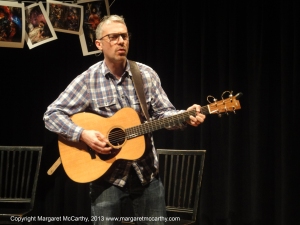



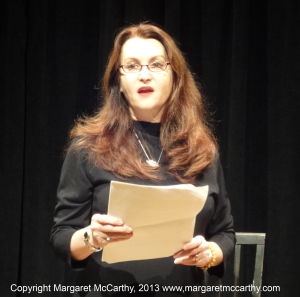

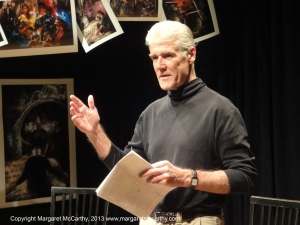

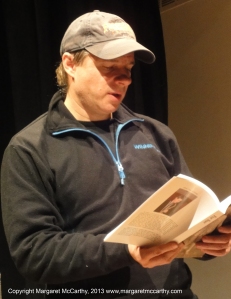




 Gabriel Byrne. Picture provided by Sandra Markus on Twitter
Gabriel Byrne. Picture provided by Sandra Markus on Twitter

 Gabriel Byrne with attendee Misty Shores, who provided the picture on Twitter
Gabriel Byrne with attendee Misty Shores, who provided the picture on Twitter


